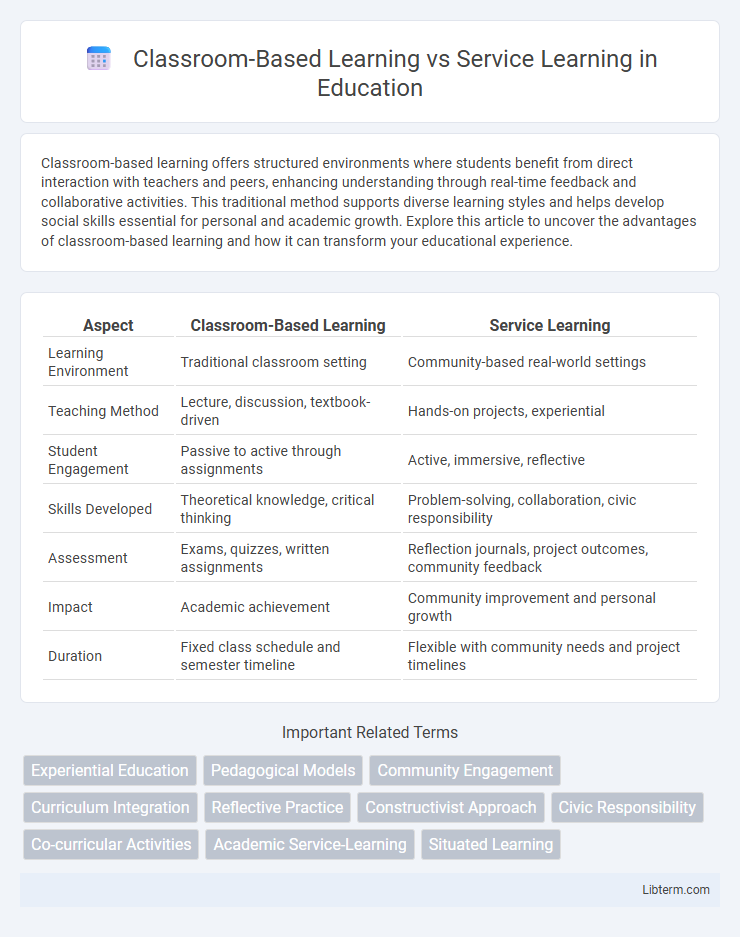Classroom-based learning offers structured environments where students benefit from direct interaction with teachers and peers, enhancing understanding through real-time feedback and collaborative activities. This traditional method supports diverse learning styles and helps develop social skills essential for personal and academic growth. Explore this article to uncover the advantages of classroom-based learning and how it can transform your educational experience.
Table of Comparison
| Aspect | Classroom-Based Learning | Service Learning |
|---|---|---|
| Learning Environment | Traditional classroom setting | Community-based real-world settings |
| Teaching Method | Lecture, discussion, textbook-driven | Hands-on projects, experiential |
| Student Engagement | Passive to active through assignments | Active, immersive, reflective |
| Skills Developed | Theoretical knowledge, critical thinking | Problem-solving, collaboration, civic responsibility |
| Assessment | Exams, quizzes, written assignments | Reflection journals, project outcomes, community feedback |
| Impact | Academic achievement | Community improvement and personal growth |
| Duration | Fixed class schedule and semester timeline | Flexible with community needs and project timelines |
Introduction to Classroom-Based Learning and Service Learning
Classroom-based learning emphasizes structured academic instruction delivered through lectures, textbooks, and standardized assessments, providing foundational knowledge in a controlled environment. Service learning integrates community service with academic coursework, promoting practical experience, civic responsibility, and reflective learning beyond the classroom. Both methods enhance student engagement but differ in their approach to skill development and real-world application.
Defining Classroom-Based Learning: Core Features
Classroom-based learning centers on structured, curriculum-driven instruction delivered in a formal education setting, emphasizing theoretical knowledge acquisition through lectures, textbooks, and assessments. Core features include a teacher-led environment, standardized content, and a focus on individual cognitive development and mastery of subjects. This method prioritizes a controlled setting where learning outcomes can be systematically measured and evaluated.
Understanding Service Learning: Key Components
Service learning integrates meaningful community service with instruction and reflection, fostering student engagement and real-world problem-solving skills. Key components include structured opportunities for students to apply academic knowledge in service settings, guided reflection to connect experiences with learning objectives, and collaboration between educational institutions and community partners. This approach enhances civic responsibility, empathy, and practical skill development beyond traditional classroom-based learning methods.
Theoretical Foundations of Both Approaches
Classroom-based learning relies heavily on behaviorist and constructivist theories, emphasizing structured knowledge acquisition through lectures, textbooks, and assessments to build foundational understanding. Service learning integrates experiential learning theory, particularly Kolb's learning cycle, highlighting active participation and reflection in real-world contexts to foster civic responsibility and critical thinking. Both approaches aim to deepen comprehension, with classroom-based learning focusing on cognitive development and service learning emphasizing practical application and social engagement.
Learning Outcomes: Knowledge Retention and Skill Development
Classroom-based learning primarily enhances theoretical knowledge retention through structured curriculum and repeated assessments, ensuring a solid foundation of subject matter. Service learning integrates practical experience with community engagement, fostering critical skill development such as problem-solving, communication, and empathy alongside academic knowledge. Combining both approaches maximizes long-term retention by contextualizing information and promoting active application of skills in real-world settings.
Real-World Application: Practical vs. Theoretical Learning
Classroom-based learning emphasizes theoretical knowledge through structured lessons, textbooks, and lectures, providing a solid foundation in core concepts and principles. Service learning immerses students in real-world environments where they apply academic skills to solve community issues, fostering practical experience and problem-solving abilities. This hands-on approach enhances critical thinking and civic responsibility, bridging the gap between theory and practical application.
Student Engagement and Motivation
Classroom-based learning often relies on structured lessons and assessments, which can limit student engagement by focusing on passive knowledge absorption. Service learning integrates community service with academic objectives, enhancing motivation through real-world application and active participation. Studies show that service learning significantly boosts student engagement by fostering a sense of purpose and practical problem-solving skills.
Assessment Methods and Evaluation Criteria
Classroom-based learning assessments primarily rely on exams, quizzes, and written assignments to evaluate student knowledge and understanding, emphasizing individual performance and theoretical grasp. Service learning assessment methods integrate reflective journals, project presentations, and community feedback to measure practical application, social impact, and personal growth alongside academic achievement. Evaluation criteria in service learning extend beyond cognitive skills to include collaboration, ethical reasoning, and real-world problem-solving, fostering a holistic assessment approach compared to traditional classroom evaluations.
Benefits and Challenges of Each Approach
Classroom-based learning offers structured content delivery and consistent assessment methods, enhancing theoretical knowledge retention but often lacks real-world application, which may limit student engagement and critical thinking development. Service learning integrates community service with academic instruction, fostering practical skills, civic responsibility, and deeper understanding through experiential learning, yet it may face challenges like variable community partner reliability and alignment with curriculum standards. Balancing these approaches requires addressing logistical issues in service learning while supplementing classroom instruction with active, hands-on experiences to optimize educational outcomes.
Choosing the Best Approach: Factors to Consider
Choosing the best approach between classroom-based learning and service learning depends on educational goals, student engagement levels, and real-world application needs. Classroom-based learning offers structured content delivery and theoretical understanding, while service learning provides experiential opportunities to develop problem-solving and civic responsibility skills. Factors such as curriculum alignment, community involvement, and assessment methods play critical roles in determining the optimal approach for maximizing student outcomes.
Classroom-Based Learning Infographic

 libterm.com
libterm.com